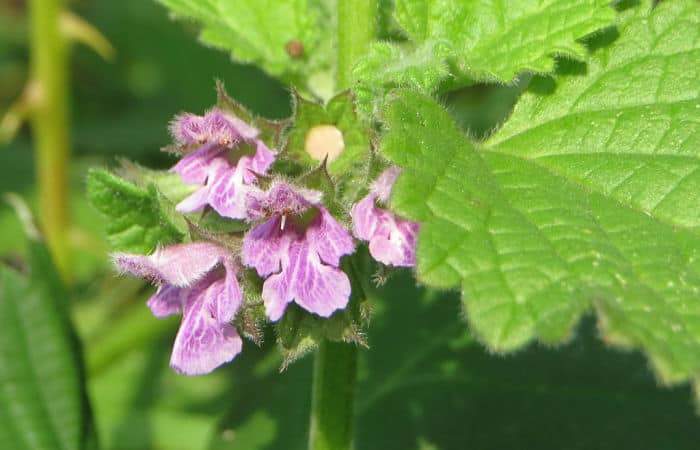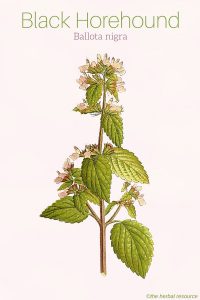Botanical Name: Ballota nigra.
In ancient Greece, the plant was known by the name “ballote” deriving from the Greek word “ballo” meaning to reject or repel. Probably because of the plant’s rather unpleasant taste and smell.
The plant’s species name “nigra” derives from the Latin word niger meaning black, referring to the blackish appearance of the herb when dried.
Other Common Names: Black horehound, stinking horehound, black stinking horehound, fetid horehound, black hemp nettle, balota (Spanish), Schwarznessel (German), ballote noire (French), hunderot (Norwegian), bonässla (Swedish), porro (Finnish), tandbæger (Danish).
Habitat: Black horehound is probably native to the Mediterranean region and western Asia, but is now widely distributed in Europe including the southern parts of Scandinavia, North Africa, and Central Asia.
The plant is now naturalized in South and North America and New Zealand.
Black horehound can often be found growing wild in fields, fallow land, forest edges and along roadsides. It prefers a nitrogen-rich, moist and well-drained soil and grows best in semi-shade or full sun.
The plant is propagated by seeds that are sown in spring, or by root-division in the autumn.
Description: Black horehound in a perennial plant that belongs to the mint or deadnettle (Lamiaceae).
It can grow up to 90 cm (3 feet) in height with erect herbaceous soft-haired stems. The plant has a taproot and the leaves are opposite, toothy, heart-shaped and covered with soft hairs.
The pink or purple flowers are organized in verticillaster and appear from July to September (northern hemisphere).
The fruit consists of four smooth cylindrical to ovoid, black nutlets. Black horehound is hermaphrodite (has both male and female organs) and like many other plants in the mint family, it is attractive to bees, butterflies, and other insects.
Plant Parts Used: The aerial parts of black horehound are used in herbal medicine.
The plant material is collected at the beginning of the flowering period, mainly from the wild, and it can be used fresh or dried. The plant has a quite unpleasant odor and taste.
The herb is used in the form of herbal tea, liquid extracts or tinctures.
The medicinal properties of the dried herb diminish over time and it should be replenished every year or so.
Medicinal Applications and Health Benefits of Black Horehound
Active Ingredients and Substances: The main active substances found in black horehound are diterpenoids (marrubin, ballonigrin, ballotinone, ballotenol and preleosibirin), phenylpropanoids (verbascoside, forsythoside B, ballotetroside, lavandulifolioside and angoroside A7).
It also contains flavonoid glycosides, tannins, essential oil, saponins, choline, organic acids, and pectin.
Medicinal Uses of Black Horehound in the Past
Black horehound has a long history of use in herbal medicine and it was once regarded to be helpful for ailments related to eyes and ears.
It was also thought that it was an effective remedy or an antidote of sorts for bites by dogs infected with rabies. Compressions or wraps of the leaves were then placed on the infected areas, which allegedly counteracted the cramps.
Although the herb is still grown to some extent in herb gardens, it is rarely used in today’s herbal medicine due to its unpleasant taste.
Now, its close relative white horehound (Marrubium vulgare) is rather used instead, which has some of the same medicinal properties, is regarded to be more effective and to say the least has a better taste.
An Anti-Nausea Herb
The whole plant is said to have an antispasmodic, expectorant and vermifuge effect and it is especially regarded to be effective in its action as an antiemetic.
Black horehound is therefore sometimes used to curb nausea and vomiting, especially when the cause is related to the nervous system and not to the digestive system.
It can, for example, be used as a remedy for traveling sickness or motion sickness, where the nausea is triggered in the inner ear and central nervous system.
The herb may also be helpful for morning sickness, or nausea caused by stress and anxiety. In that regard, the herb is often used in conjunction with meadowsweet (Filipendula ulmaria) and chamomile (Matricaria recutita).
Black Horehound has Sedative Effect
Black horehound has some sedative properties and it has been used traditionally for the symptomatic treatment of mild forms of nervousness, anxiety, and insomnia in both adults and children.
The herb has also be used as a remedy for loss of appetite, indigestion, intestinal worms, irregular menstruation, some menopause symptoms, and as a mild expectorant agent for treating ailments associated with the respiratory system, such as a sore throat, cough, bronchitis and mild cases of a whooping cough (pertussis).
The gentle sedative effect of black horehound may come from it essential oil, which has an unpleasant odor. Something it has in common with another soothing herb, namely valerian (Valeriana officinalis), which is also known for its unagreeable smell.
In addition, the herb has astringent properties and may be used externally to treat minor skin rashes, insect bites, and sunburn. It can also be applied topically in the form of a compress as a relief for rheumatic diseases such as gout.
Dosage and Administration
As a tea: Add 1 or 2 teaspoons of the dried herb to a cup of boiling water and let it draw for 10-15 minutes before straining. For therapeutic purposes, three cups of the tea can be drunk daily. The tea can also be used in compresses.
As a fluid extract: 1: 1 in 25% alcohol. 3.1 mL three times daily,
As a tincture: 1: 1 in 45% alcohol. 1-2 ml three times a day.
Possible Side Effects and Interactions of Black Horehound
There are no reports of contraindications, side effects or interactions with conventional medication or other medicinal herbs with the proper use of black horehound as a medicinal herb.
The plant, however, is thought to affect the menstrual cycle and it is recommended that pregnant and breastfeeding women consult a professional healthcare provider before using the herb.
Generally, it is not recommended to use black horehound in large doses over a long time.
Supporting References
Atkins, Rosie, et al.: Herbs. The Essential Guide for a Modern World. London, Rodale International Ltd. 2006.
Barnes, Joanne; Linda A. Anderson & J. David Phillipson: Herbal Medicines. A guide for healthcare professionals. Second edition. London, Pharmaceutical Press 2002.
Bown, Deni: The Royal Horticultural Society New Encyclopedia of Herbs & Their Uses. London, Dorling Kindersley 2002.
Gruenwald, Joerg et al.: PDR for Herbal Medicines. Fourth Edition. Montvale, New Jersey, Thomson Healthcare Inc. 2007.
Hoffmann, David: Medicinal Herbalism. The Science and Practice of Herbal Medicine. Rochester, Healing Art Press 2003.
Skenderi, Gazmend: Herbal Vade Mecum. 800 Herbs, Spices, Essential Oils, Lipids Etc. Constituents, Properities, Uses, and Caution. Rutherford, New Jersey, Herbacy Press 2003.
van Wyk, Ben-Erik & Michael Wink: Medicinal Plants of the World. Portland, Oregon, Timber Press 2004.
Williamson, Elisabeth M.: Potter’s Herbal Cyclopaedia. Essex, Saffron Walden 2003.
Thordur Sturluson
Latest posts by Thordur Sturluson (see all)
- What is the Difference Between Hemp and Marijuana? - June 3, 2019


I am unfamiliar with the usage of the term ‘aerial’ in your Parts used section, which was not further clarified.: ‘Please explain what parts of the plant, particularly before blooming, these are. Otherwise, thank you for the information.
Aerial parts of the plant mean parts which are completely exposed in air, including the stems, leaves, petioles, flowers, fruit, and seeds.
I have found that tincture of Black Horehound can be very helpful for migraine-induced nausea and dizziness. The slightly bitter flavour is really not that bad, and rather comforting. It feels as if the body “welcomes” it.
Combined with a fresh ginger root piece (nibbled with a bit of honey) it helps reduce the symptoms.